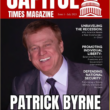I feel the same strange admiration for Michael Steinhardt as one would for an old mobster sitting in a Tucson retirement home playing canasta. Steinhardt slipped through minefields that destroyed others, and for that alone he should be beyond cheap shots now. However, without telling Steinhardt’s story there is no way for me to make the connections that I wish to make, so I will relate the Steinhardt Tale, in four acts, with none of the shots being cheap ones.
Some years ago, I asked a Wall Street old-timer to summarize how Michael Steinhardt would be remembered. The old-timer was unusually pensive. A faraway look came into his eyes as he seemed to recall how the Street had once been, and how it had changed.
At last he replied, “Steinhardt? That’s when the bad guys came to town.”
Prelude
The central character of Mario Puzo’s The Godfather was “Vito Corleone” (played in the movie by Marlon Brando). Don Corleone was modeled after real-life Mob boss Vito Genovese, who headed the Genovese Crime Family. Other figures from this family include Charles “Lucky” Luciano, Frank Costello, Bugsy Siegel, Meyer Lansky (“Hyman Roth” in Godfather II), and Vincent “Jimmy Blue Eyes” Alo.
The Genovese Crime Family had a fence named Sol Frank “Red” Steinhardt, who was arrested in 1958 on charges of buying and selling stolen jewelry. The prosecutor at Red Steinhardt’s trial, Frank Hogan, described Red Steinhardt as “the biggest Mafia fence in America.” Red was sentenced to 5-10 years on each of two charges of fencing, and served several years at Sing Sing, a prison just north of New York City.
While in prison, Red Steinhardt put his son Michael through the University of Pennsylvania’s Wharton School of Business. When Michael Steinhardt finished Wharton in 1967 he started an early hedge fund, “Steinhardt, Fine, Berkowitz & Co.” As Michael later revealed in his book, cash from Steinhardt’s father and his “associates” funded his hedge fund. Thus, it was a conduit by which Mob cash passed into Wall Street (one former prosecutor shared with me an elegant phrase a Mafia suspect used under interrogation: “Yeah, in da 70’s weeze went from concrete to Wall Street”).
Michael Steinhardt Act I
Steinhardt’s first act was notable in three ways:
a) In the early 1970’s Steinhardt was a close financial associate of an international oil trader and general bon vivant named Marc Rich.
b) From his start in the early 1970’s, Steinhardt’s reputation was that of a hater, an in-your-face profanity-laced screamer of unprecedented proportions. Nothing I have ever seen from Hollywood captures the way I have seen it occur in reality on Wall Street, yet in that environment, Steinhardt’s verbal brutality towards others, including towards his subordinates, became the stuff of legend. For example, there is a story that may be true, or it may be apocryphal, but whichever it is, it is widely repeated around Wall Street: in the early 1990’s Steinhardt had a partner, Peter Toczek of the New York and Foreign Securities Corporation, who handled Steinhardt’s overnight trading. They were considered close (I even heard that Peter and Michael were “godfather” to each other’s children, but cannot verify that). As the story goes, Peter was paid a bonus that was smaller than he (Peter) expected, and he confronted Steinhardt over it. Steinhardt screamed at Toczek so abusively that all conversation in the office ceased, then continued berating and humiliating Toczek so badly that Toczek was reduced to tears. Toczek left for the day, went home, and keeled over, dead. Steinhardt showed no regret. (Whenever I hear this I think of the Eddie Murphy/Dan Akroyd movie Trading Places, where an essentially similar event transpires between Mortimer and Randolph Duke). Be this incident true or not (and in fairness to Steinhardt, Toczek is said to have topped out at 300 pounds), what is undeniable is that from the early 1970’s on Steinhardt was well-known for being absolutely brutal in his interactions with others.
c) The other technique Steinhardt pioneered in the 1970’s was an extremely aggressive trading style centering upon, “The Edge.” What “The Edge” means is “information asymmetry.” One person who worked at a major brokerage covering Steinhardt described to me their first encounter, decades ago: “We came out with a downgrade on a stock, I think it was GM. Minutes later I got a call from Steinhardt. ‘You fucking asshole,’ he said. ‘Why didn’t I know about this thirty minutes ago?'” (In other words, Steinhardt was demanding to know why he had not been tipped off to the coming downgrade.) “I told him, ‘Come on Mr. Steinhardt. You know that would be illegal. You know I can’t do that.’ Steinhardt told me, ‘You dumb fucking kid, you know the way the game is played. You look at how much vig I pay your firm each month and you tell me that.'” (Another Wall Street money manager who worked in these circles tells me, “Steinhardt always liked to get what he called, ‘fancy information.’ You know, analysts’ upgrades and downgrades, before the market got them. Steinhardt would tell them, “You want my business? You gotta get me some fancy information. That’s how you win my business.” )
Together, the screaming and “the edge” explain Steinhardt’s success: bullying people to get them to cough up “fancy information” minutes before the rest of the market has it (which makes it “fancy” no more), placing gigantic bets on that information, making tiny percentages from each, and rewarding providers of information with trading commissions while starving those who don’t play ball. That, anyway, is how Steinhardt is remembered (compare this with, say, Warren Buffett, whose “edge” is that he removed himself to Omaha to stay away from such Wall Street chatter, and who instead relies on business acumen and economic insight).
In fairness to Steinhardt, I do not mean to suggest that he was alone in seeking “The Edge”. He may have sought it more aggressively than those who came before him, but his methods pale in comparison with those of certain current money managers who will themselves be the subjects of later pieces.
Steinhardt Act II
Steinhardt’s second act also contained three scenes.
a) In the early 1980’s Steinhardt’s buddy Marc Rich turned out to be a traitor who was secretly doing oil business with Libya and Iran in violation of a number of US laws. This was a felony, as were the tax evasion schemes by which he hid his profits (Time: “The Marc Rich Case: A Primer“). Marc Rich the Traitor fled the United States with his associate “Pinky” Green for Zug, Switzerland, where he would become the most notorious fugitive financier since Nixon’s friend Robert Vesco (Slate: “Know Your Fugitive Financiers“). His present net worth is estimated at $1.2 billion (it is also uncertain as to whether he is or is not a US citizen, as for years he has neither paid US taxes nor renounced his citizenship).
b) Steinhardt morphed his hedge fund into a solo act: “Steinhardt Partners.” He also morphed politically: originally a Goldwater Republican, in the 1980’s Steinhardt played a leading role in the development of the new “Democrat Leadership Council,” and became its chairman in 1985. The DLC is the centrist Democrat group out of which Bill Clinton emerged onto the national stage. This brought him into close proximity with Marty Peretz, who parlayed his skill in marrying a Singer Sewing Machine heiress into becoming publisher of The New Republic (which I believe he has since sold, though he retains editorial control).
c) Another notable thing Michael Steinhardt did, at least according to the SEC and US Department of Justice, was in April and May, 1991 collude with another hedge fund, “Caxton”, to organize a scheme to manipulate the market in US Tresury Securities, a scheme which netted him tens of millions of dollars (Forbes put the number at $600 million). As a FOB (Friend of Bill) he is said to have been irked when President Clinton would not intervene on his behalf with the Department of Justice. However, Steinhardt’s pique may have been mollified when, in December, 1994, the DOJ settled the case for a $70 million fine and a lifetime promise to keep such crooked schemes out of the United States Treasury market (permanent consent decrees are a way of saying, “I may not have done it but I promise not to do again that thing I didn’t do”: when I see them, I think of the financial equivalent of Hannibal Lecter in a straight-jacket and mask, someone who can never be trusted around civilized peoples’ money).
Interestingly, accounts of this episode that I find in the press rarely fail to mention the tens (if not hundreds) of millions that Steinhardt made from the act. It appears to me that Steinhardt’s sense of shame is more developed than his sense of guilt, and hence, by making sure that the story is told in such a way that he appears to have had the last laugh on the DOJ, Steinhardt’s sense of shame is appeased. No sense of guilt, of course, can be invoked in such people (i.e., “sociopaths”).
Steinhardt Act III
After skating through his SEC and DOJ issues, Michael Steinhardt got busy reinventing himself as a friend to all mankind and general Great American. His first act as a Great American was to approach then-President Bill Clinton seeking a pardon for his good friend Marc Rich the Traitor (the billionaire who made his fortune doing deals with Iran and Libya while they were taking Americans hostage and killing GI’s in Berlin nightclubs). Steinhardt’s December 7, 2000 letter to Bill Clinton seeking a presidential pardon for Marc Rich the Traitor is remarkable to me in numerous ways. I respectfully suggest you read it here because I am going to spend some time on it, as I think it reveals a great deal about Great American Michael Steinhardt.
Steinhardt’s letter opens, “Dear Mr. President, I think you may remember me…” Given that Steinhardt was Chairman of both the DLC and Progressive Policy Institute, which were Bill Clinton’s left and right skates through the Democratic Party in his rise to power, such coyness is scarcely credible.
“I became involved in the political world in the mid 80’s primarily because of my interest in ‘ideas’…” It is interesting to me that he put the word “ideas” in quotes. Whether they were intended as scare-quotes, or as some subtle nudge in a code known only to them, I do not know.
“Invariably, life is filled with conflictual judgments and none of us escapes unscathed,” opines Steinhardt before coming, in the second sentence of the second paragraph, to his request: “I am writing this letter, Mr. President, to appeal to you on behalf of my friend, Mr. Marc Rich, who, I think, has been punished enough.” At the risk of being schoolmarmish, I draw attention to the numerous infelicities of grammar and style, and note how odd it seems to find them in a letter to a sitting US president from a well-educated Wall Street tycoon. I hazard a guess that this was composed in some haste and not reviewed by a lawyer (who generally write competently). Again, this fact is mildly interesting.
At the crux of Steinhardt’s letter, where we would expect to find a semblance of argument, we find instead this odd collection of statements:
“While there remains controversy as to the facts surrounding Marc Rich’s indictment in the early 1980’s, there’s no doubt he was a successful person both, before and after, (sic) that horrific experience.” The “controversy” about Rich is that after breaking US law by trading with Iran and Libya he became a fugitive hiding out in Zug, Switzerland rather than face legal consequences for his actions. Steinhardt leaves unstated why a person’s “success” should generally make him a good candidate for a pardon. It is also interesting because in the case of Marc Rich, “success” meant “making money breaking US laws by doing business with nations which were kidnapping and killing Americans.” Steinhardt’s statement is also interesting in that it recasts Marc Rich’s actions from traitorous felonies into “a horrific experience” for Marc Rich (“playing the victim” scarcely describes this). Lastly, again I note the childish grammatical errors.
“It would not be possible to recreate the circumstances surrounding a highly complicated series of facts occurring over a long period in the early 1980’s.” That much is correct. It’s what happens when one flees the country for two decades. Why the difficulties created by this additional felony should count in Marc Rich’s favor, as opposed to counting against him, Steinhardt leaves unstated.
“For Marc Rich, whose personal life has already been burdened by the profound constraints imposed by the circumstances of this case punishment (sic), have been in some ways severe. He could not properly mourn his daughter. He could not live with his children or grandchildren. He has suffered more than most. As in his (sic) mid 60’s, there would be nothing more important to him than to return to the United States of America and to live in peace.” Steinhardt’s letter, which is a compilation of intellectual gibberish, reaches a crescendo in this description of the hardships that Marc Rich the Traitor has endured. Marc Rich made a fortune committing numerous felonies, fled the country with his fortune, and has lived as a fugitive ever since: this has imposed a hardship on Rich and his fortune because his family remained in the country he betrayed, but now he wants to return to that country with his fortune without facing legal consequences for his acts, and therefore he should be allowed to do so. As an old professor of mine used to say, “I understand everything but the ‘therefore’.”
“I have known Marc Rich for more than twenty-five years. I assure you that Marc Rich’s moral and ethical standards amply justify your consideration of his pardon, so that in his remaining years he could fulfill his highest aspirations (sic), which will make all of us, as Americans, proud.” What can we learn from this bizarre claim? We learn that Marc Rich the Traitor, indicted felon and fugitive financier, has “moral and ethical standards” to which Michael Steinhardt looks up: I suspect that much is true. We also learn that Marc Rich has aspirations to return to this country, and he should be allowed to do so because…. he has aspirations to do so. Why the aspirations of billionaire fugitive felon traitors should be accommodated is something Steinhardt considers so obvious as to need no defense.
As far as I can see, Steinhardt’s sole argument in this letter is that Marc Rich should be accommodated because he is “successful.” And we should be proud of successful men and their aspirations because we – are — Americans. And we should be proud of that, too, dammit. Unless we get a good deal on some Libyan Light Crude.
This lack of argument notwithstanding, on his last morning in the White House, Bill Clinton pardoned Marc Rich. Bill was unusually close-mouthed about his reasons, saying only that he had become “impressed” with the case for pardoning Marc Rich. How that “case” was presented (or on what size check) is something that Clinton archivists refused to release to the press just last week, seven years after the events in question. Marc Rich’s attractive socialite wife Denise Rich also played a role in convincing Bill Clinton of the merits of this case, though precisely how she posed her “case” remains similarly unknown.
Another interesting event from Michael Steinhardt’s third act is that he got involved in the creation of an elite private school in New York City, the plans for which were scrapped from fear it might tolerate miscegenation (that is, the creation of mixed ethnicity couples). I am not writing of some half-educated redneck preacher’s college, I am writing about a proposed elite private school in Manhattan. I tend to be a “whatever makes you happy” kind of guy, but there are lines for me, and they exist this side of philanthropy that takes as a paramount concern the possible co-mingling of races.
Michael Steinhardt, Act IV
How is Michael Steinhardt currently regarded? A man who got his start with and became a conduit for Mafia cash on Wall Street? A man whose personal brutality became the stuff of Wall Street lore (e.g., dressing down a longtime partner to the point of cardiac arrest)? A man who joined that personal brutality to a system of high fees paid to knowledgeable insiders to develop “the edge” with which he could rob “the dumb money” not privy to that information? A man who made tens if not hundreds of millions of dollars tampering with the market for United States Treasury securities, then bought his way out of trouble with a $70 million payment and a lifetime promise to wear the financial equivalent of a Hannibal Lecter mask around the US Government’s money? A man who was financier to a fugitive felon trading with our nation’s enemies, then obtained a presidential pardon for that traitorous crony? A man who lets his philanthropy be constrained by bigotry?
Thanks to the wonders of a PR agency known as, “the New York press corps,” the man is now considered a deep-thinking financial statesman, philanthropist, and yes, Great American.
Dénouement
Steinhardt Partner’s head trader was Karen Backfisch, also known as “The Trading Goddess,” who has often been described as “Steinhardt’s protégé.”
Jim Cramer, the television personality, publicly emphasizes his career at Goldman Sachs followed by his time spent running his own hedge fund. In truth, however, as soon as he left Goldman Sachs, Jim Cramer spent 1-2 years ensconced in Steinhardt’s offices at the Burroughs Building in Manhattan. Cramer housed in Steinhardt Partners and his office was three doors down from Michael Steinhardt’s.
Karen Backfisch met Jim Cramer there in Steinhardt’s offices, and they married. As will be discussed shortly, Jim has publicly acknowledged that what he knows about trading he gleaned from Karen Backfisch, which knowledge she had gained as Steinhardt’s head trader.
Before Karen Backfisch, Steinhardt had another protégé, in the early 1970’s, fresh out of Harvard’s MBA program. His name is “David Rocker,” and I will have something to say about him soon as well.
And so ends the tale of when the bad guys came to Wall Street.




I remember reading a tiny little article in ,i believe,the wall street journal around the summer of 2000,just a few sentences,and it basically said something to the effect ,jim cramer was removed from his hedge fund by sec investigators,his lawyers worked out a deal where he paid very large fines and narrowly escaped jail time and he was prohibited from investing the publics funds in the future,and i thought that was why he then went on tv with kudlow and then his own show.I know i read the article,i didnt make it up just made a mental note of it, my imagination is not that vivid, but ive never seen refernce to those events again.strange.And since then everytime i hear how cramer resinged from his hedge fund i thought just another lie,he was actually removed.Admitted addicts like him dont just quit.